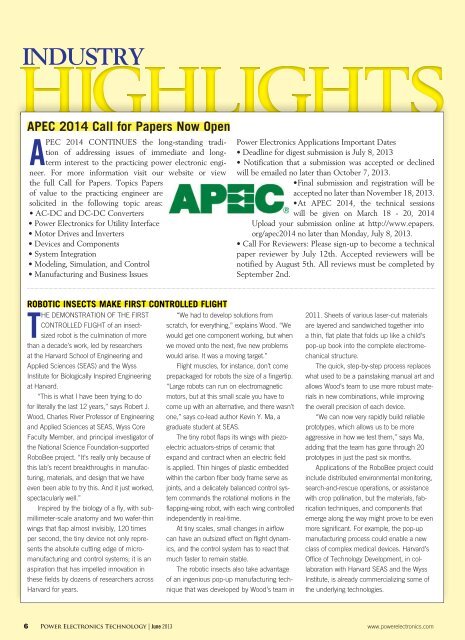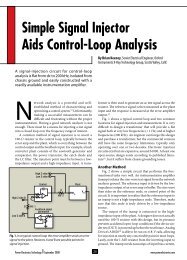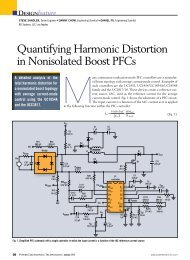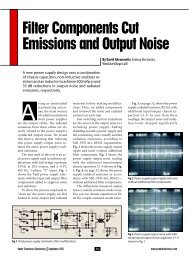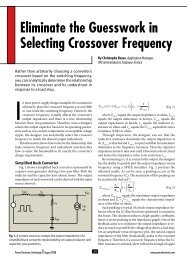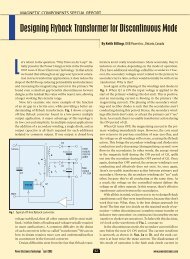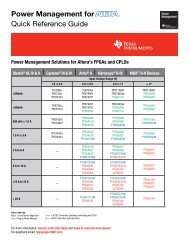Power Electronics Technology
Power Electronics Technology
Power Electronics Technology
Create successful ePaper yourself
Turn your PDF publications into a flip-book with our unique Google optimized e-Paper software.
INDUSTRY<br />
APEC 2014 Call for Papers Now Open<br />
APEC 2014 CONTINUES the long-standing tradition<br />
of addressing issues of immediate and longterm<br />
interest to the practicing power electronic engineer.<br />
For more information visit our website or view<br />
the full Call for Papers. Topics Papers<br />
of value to the practicing engineer are<br />
solicited in the following topic areas:<br />
• AC-DC and DC-DC Converters<br />
• <strong>Power</strong> <strong>Electronics</strong> for Utility Interface<br />
• Motor Drives and Inverters<br />
• Devices and Components<br />
• System Integration<br />
• Modeling, Simulation, and Control<br />
• Manufacturing and Business Issues<br />
ROBOTIC INSECTS MAKE FIRST CONTROLLED FLIGHT<br />
THE DEMONSTRATION OF THE FIRST<br />
CONTROLLED FLIGHT of an insectsized<br />
robot is the culmination of more<br />
than a decade’s work, led by researchers<br />
at the Harvard School of Engineering and<br />
Applied Sciences (SEAS) and the Wyss<br />
Institute for Biologically Inspired Engineering<br />
at Harvard.<br />
“This is what I have been trying to do<br />
for literally the last 12 years,” says Robert J.<br />
Wood, Charles River Professor of Engineering<br />
and Applied Sciences at SEAS, Wyss Core<br />
Faculty Member, and principal investigator of<br />
the National Science Foundation-supported<br />
RoboBee project. “It’s really only because of<br />
this lab’s recent breakthroughs in manufacturing,<br />
materials, and design that we have<br />
even been able to try this. And it just worked,<br />
spectacularly well.”<br />
Inspired by the biology of a fly, with submillimeter-scale<br />
anatomy and two wafer-thin<br />
wings that flap almost invisibly, 120 times<br />
per second, the tiny device not only represents<br />
the absolute cutting edge of micromanufacturing<br />
and control systems; it is an<br />
aspiration that has impelled innovation in<br />
these fields by dozens of researchers across<br />
Harvard for years.<br />
“We had to develop solutions from<br />
scratch, for everything,” explains Wood. “We<br />
would get one component working, but when<br />
we moved onto the next, five new problems<br />
would arise. It was a moving target.”<br />
Flight muscles, for instance, don’t come<br />
prepackaged for robots the size of a fingertip.<br />
“Large robots can run on electromagnetic<br />
motors, but at this small scale you have to<br />
come up with an alternative, and there wasn’t<br />
one,” says co-lead author Kevin Y. Ma, a<br />
graduate student at SEAS.<br />
The tiny robot flaps its wings with piezoelectric<br />
actuators-strips of ceramic that<br />
expand and contract when an electric field<br />
is applied. Thin hinges of plastic embedded<br />
within the carbon fiber body frame serve as<br />
joints, and a delicately balanced control system<br />
commands the rotational motions in the<br />
flapping-wing robot, with each wing controlled<br />
independently in real-time.<br />
At tiny scales, small changes in airflow<br />
can have an outsized effect on flight dynamics,<br />
and the control system has to react that<br />
much faster to remain stable.<br />
The robotic insects also take advantage<br />
of an ingenious pop-up manufacturing technique<br />
that was developed by Wood’s team in<br />
<strong>Power</strong> <strong>Electronics</strong> Applications Important Dates<br />
• Deadline for digest submission is July 8, 2013<br />
• Notification that a submission was accepted or declined<br />
will be emailed no later than October 7, 2013.<br />
• Final submission and registration will be<br />
accepted no later than November 18, 2013.<br />
• At APEC 2014, the technical sessions<br />
will be given on March 18 - 20, 2014<br />
Upload your submission online at http://www.epapers.<br />
org/apec2014 no later than Monday, July 8, 2013.<br />
• Call For Reviewers: Please sign-up to become a technical<br />
paper reviewer by July 12th. Accepted reviewers will be<br />
notified by August 5th. All reviews must be completed by<br />
September 2nd.<br />
2011. Sheets of various laser-cut materials<br />
are layered and sandwiched together into<br />
a thin, flat plate that folds up like a child’s<br />
pop-up book into the complete electromechanical<br />
structure.<br />
The quick, step-by-step process replaces<br />
what used to be a painstaking manual art and<br />
allows Wood’s team to use more robust materials<br />
in new combinations, while improving<br />
the overall precision of each device.<br />
“We can now very rapidly build reliable<br />
prototypes, which allows us to be more<br />
aggressive in how we test them,” says Ma,<br />
adding that the team has gone through 20<br />
prototypes in just the past six months.<br />
Applications of the RoboBee project could<br />
include distributed environmental monitoring,<br />
search-and-rescue operations, or assistance<br />
with crop pollination, but the materials, fabrication<br />
techniques, and components that<br />
emerge along the way might prove to be even<br />
more significant. For example, the pop-up<br />
manufacturing process could enable a new<br />
class of complex medical devices. Harvard’s<br />
Office of <strong>Technology</strong> Development, in collaboration<br />
with Harvard SEAS and the Wyss<br />
Institute, is already commercializing some of<br />
the underlying technologies.<br />
6 <strong>Power</strong> <strong>Electronics</strong> <strong>Technology</strong> | June 2013 www.powerelectronics.com


